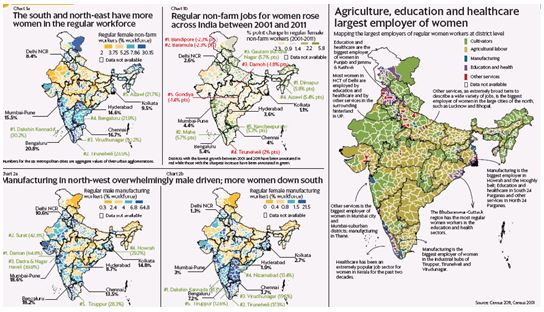ForumIAS announcing GS Foundation Program for UPSC CSE 2025-26 from 19 April. Click Here for more information.
ForumIAS Answer Writing Focus Group (AWFG) for Mains 2024 commencing from 24th June 2024. The Entrance Test for the program will be held on 28th April 2024 at 9 AM. To know more about the program visit: https://forumias.com/blog/awfg2024
South and East India offer more jobs to women
News
The recent remark by Union HRD Minister about women remaining outside workforce “out of choice” has raised controversy
Important facts
National Status: According to ILO estimates, female labour force participation rate (FLPR) has decreased from33.8% in 2000to 27.3% 2015. ILO further projects that FLPR is expected to reach 24% by 2030.
Female Workforce in Agriculture:
- According to the NSSO data (2011-12) the sharp drop in the female labour force participation rate compared with the mid-2000s has been largely concentrated in rural parts of the country, driven by agriculture.
- The decline in female agricultural labour force was caused by an improvement in rural wages ad living conditions
Female workforce in Non-farm Employment:
- Women in regular non-farm jobs account for less than one fifth (19%) of the regular workforce and less than one-tenth (9%) of the overall workforce.
- There is regional disparity in female labour force participation rate across India with south and eastern India engaging more women in non-farm sectors than North and western India
- Among states, Manipur (33.3%), Mizoram (33%), and Meghalaya (31.7%) have the highest share of women in regular non-farm jobs. Among large states (with 10 million plus population), Tamil Nadu (25%), Karnataka (24.5%) and Andhra Pradesh (23.8%) have more women in regular non-farm jobs than others.
- Across different sectors, education and healthcare employ the majority of women workers.
Reasons for low female labour force participation
- Under-developed Manufacturing sector: A major reason for share of women in workforce being low is the relatively small size of India’s manufacturing sector.
- Cultural norms and stigma: In a patriarchal society like India, cultural norms and stigmas attached to women working outside and participating in economic activities are rampant and impedes women from working.
- Work and time: women disproportionately borne the burden of domestic responsibilities and this impedes women from working outside.
- Household Income Security: Due to rising household income in both rural and urban India, the financial necessity of women to engage in outside work has dropped.





